Hamilton McWhorter III
Commander Hamilton McWhorter III (February 8, 1921 – April 12, 2008) was a United States Navy aviator and a flying ace of World War II, credited with shooting down twelve Japanese aircraft. He was the first Hellcat ace, first USN carrier-based double ace,[2][3] and the first Grumman F6F Hellcat pilot to achieve double ace status.[4][5] He flew 89 combat missions during World War II while flying with the VF-9 and VF-12 units.[5] On 23 May 2014, he was also posthumously awarded the American Fighter Aces Congressional Gold Medal on which a navy pilot is depicted.[6][7]
Hamilton McWhorter III | |
|---|---|
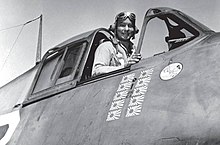 | |
| Nickname(s) | "Mac", "One Slug" |
| Born | February 8, 1921 Athens, Georgia |
| Died | April 12, 2008 (aged 87) El Cajon, California |
| Buried | |
| Allegiance | |
| Service/ | United States Navy |
| Years of service | 1942 to 1969 |
| Rank | Commander |
| Unit | VF-9 VF-12 |
| Commands held | VF-12 |
| Battles/wars | World War II
|
| Awards | |
| Relations | Wife: Louise (Née Edel) McWhorter |
Early life and education
Hamilton McWhorter III was born in 1921 to a middle class family. His first flight happened when he was 9 years old.[5] The family lived on a farm and when he was 9 he got his first shotgun. He was enrolled at the University of Georgia from 1939–1941.[8] He attended Civilian Pilot Training in 1939,[8] and entered the Navy flight program in August, 1941.[8]
Navy career
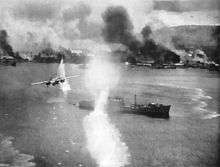
McWhorter was selected for fighter training and arrived for training in Miami on 24 December 1941. He graduated from flight school on 28 January 1942 and was commissioned as an ensign on 9 February.[8] Advancing to carrier training on the F4F Wildcat at Naval Air Station Norfolk, McWhorter joined Fighting Squadron 9 (VF-9), based at East Field on NAS Norfolk, after completing the program in late April.[9] In early October he and the squadron embarked aboard the USS Ranger for Operation Torch, the Allied invasion of Vichy French North Africa.[10][5] McWhorter flew in an airstrike against Casablanca when the invasion began on 8 November.[11] After Vichy French resistance ceased, the Ranger returned to Norfolk. Based at nearby NAS Oceana from December, VF-9 converted to the new F6F-3 Hellcat in early 1943, among the first squadrons to receive them. McWhorter found the Hellcat a "dream to fly" and much superior to the Wildcat.[12] During this period at Norfolk McWhorter met Louise Edel, the daughter of a Navy chaplain, and married her on 16 January.[13]
In May 1943 VF-9 departed for the Pacific Theater aboard the newly commissioned carrier Essex.[12] He was nicknamed "One Slug" McWhorter after his first kill over Wake Island on 5 October 1943, when McWhorter flew into a formation of Japanese aircraft (Zeroes), and fired one .50 caliber bullet into the plane. The plane exploded and McWhorter earned his first enemy kill. The men in his unit said he was conserving the taxpayers money by only firing one slug. McWhorter later stated that he only fired one shot because the plane blew up.[5]
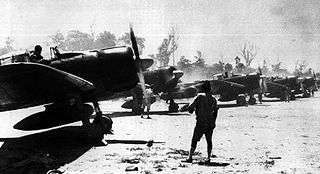
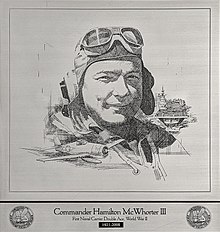
On a mission escorting SBD Dauntless dive bombers over Rabaul on 11 November 1943, McWhorter downed two Zeroes.[5][14] McWhorter's Hellcat was hit several times in the attack but he was able to land on the USS Essex. The Hellcat sustained bullet holes on both sides of the fuselage and several that that went straight through each wing.[5] During the 17 February 1944 Operation Hailstone airstrikes on Truk, McWhorter downed three Zeroes, bringing his score to ten victories. He thus became the first Hellcat double ace and the first carrier pilot to reach double ace status.[15][5] In his memoirs, McWhorter described the engagement: "My wingman and I ran into three Zekes. The first had a perfect bead on me, but for some reason didn't fire and Bud knocked him down. The other two ran right into my sights, one after the other, inside ten seconds and went down. Less than a mile away another Zero (later identified as "Hamp") was bearing down on me. He could have got me, but strangely, he didn't fire either. I let him have a burst and set him afire."[16]
The Essex arrived at San Francisco on 10 March, and her pilots dispersed for a month-long leave. After meeting his parents-in-law for the first time at Naval Training Station Sampson and visiting his family in Athens,[13] McWhorter was posted to the reforming VF-12 as one of its veteran cadre.[17] VF-12 was attached to USS Randolph in 1945, and McWhorter claimed two more Japanese aircraft to raise his victory total to 12.[18]
McWhorter was awarded the Distinguished Flying Cross five times in recognition of his actions. He was among the seven original inductees into the Georgia Aviation Hall of Fame when the latter was established in 1989.[1][19][20]
After the war, McWhorter was given command of VF-12 (an aviation unit of the United States Navy).[18][21]
He ended his Navy career as executive officer of Naval Air Station Miramar in 1969 and retired to El Cajon.[22] McWhorter's memoir, coauthored by Jay Stout, was published by Pacifica in 2001 as The First Hellcat Ace.[23][24][25] After retirement, he became an instructor at Gillespie Field, training many airline pilots.
Affiliations
He was a member of the American Fighter Aces Association, the Distinguished Flying Cross Society and the Tailhook Association.[22]
Awards
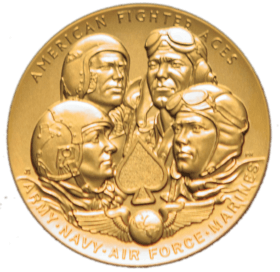
- 5 Distinguished Flying Crosses[26]
- Permanent Citation for the Gold Star awarded by Secretary of the Navy James Forrestal (1947)[27]
- Georgia Aviation Hall of Fame (1989)[19][20]
- 3 Air Medals[27]
- Congressional Gold Medal awarded to American fighter aces, collectively May 23, 2014[6][28]
Personal
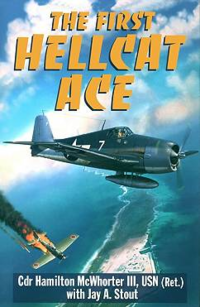
In January 1943 he married to Louise (née Edel) McWhorter. Together they had 5 children: Donald, Bill, Georgia, Hamilton, and Jon.[29] He retired as a Navy commander in 1969 in El Cajon, California.[5]
Published work
- McWhorter, Hamilton; Stout, Jay A. (2001). The First Hellcat Ace. Pacifica, California: Pacifica Press. ISBN 0935553495. ISBN 9780935553499.[30]
References
- Plaque of McWhorter at the Georgia Aviation Hall of Fame
- "Air Force Journal of Logistics, Volumes 16-18". Air Force Logistics Management Center. XVI NO 1 (Winter AFRP-1): 28. 1992. Retrieved 25 July 2020.
- Hammel 2010, p. 129.
- Stout 2013, p. 77 69-83.
- Dorr, Robert F. (21 October 2019). "Sharp Shooting Hellcat "Mac" McWhorter Runs Up the Score" (PDF). Flight Journal. p. 16. Retrieved 22 July 2020.
- 113th Congress. "H.R.685 – American Fighter Aces Congressional Gold Medal Act". Congress.gov. Library of Congress. Retrieved 22 July 2020.
- "American Fighter Aces to Hold 50th Reunion". Museum of Flight. The Museum of Flight. May 22, 2014. Retrieved 22 July 2020.
- Cleaver 2017, p. 79.
- Young 2014, pp. 8–9.
- Cleaver 2018, p. 137.
- Young 2014, pp. 10–12.
- Young 2014, pp. 16–18.
- "High U. S. Score Against Japs Traced to U. S. Air Teamwork". Rochester Democrat and Chronicle. 2 April 1944. p. B12 – via Newspapers.com.
- Young 2014, p. 27.
- Tillman 1979, p. 60.
- Young 2014, p. 43.
- Young 2014, p. 49.
- "Ledr. McWhorter Given Command of VF-12". Jacksonville Jax Air News. 3 December 1953. p. 5. Retrieved 22 July 2020.
- Danilov 1997, p. 159.
- Burson, Pat (August 27, 1989). "State Inducting Seven Into Aviation Hall of Fame". Atlanta Journal-Constitution. p. B5. Retrieved October 8, 2018 – via newspapers.com.
- "Florida Ace Leading Navy list; has 34". Tucson Daily Citizen. 24 February 1945. Retrieved 22 July 2020.
- Gonzalez, Blanca (April 24, 2008). "Hamilton "Mac" McWhorter; former Navy commander had an early love of flying". San Diego Union-Tribune. Retrieved 21 July 2020.
- Mersky, Peter B. (March–April 2002). "Professional Reading" (PDF). Naval Aviation News. p. 40.
- McWhorter & Stout 2001.
- "Stout, Jay A". encyclopedia.com. Retrieved July 22, 2020.
- Stout 2013, pp. 69-83.
- "Naples Navy Aviator Awarded Gold Star". Long Beach Independent. 13 January 1947. p. 16. Retrieved 22 July 2020.
- Vogt, Tom (8 February 2016). "Off Beat: WWII pilot one of the faces of America's fighter aces". The Columbian. Retrieved 22 July 2020.
- "Louise Edel McWhorter". San Diego Union-Tribune. Legacy.com. January 27, 2019. Retrieved July 22, 2020.
- McDonald, Bill (2006). "The First Hellcat Ace by Hamilton McWhorter MWSA Review".
Bibliography
- Cleaver, Thomas McKelvey (2017). Pacific Thunder: The US Navy's Central Pacific Campaign August 1943 – October 1944. Oxford UK: Osprey Publishing. p. 79. ISBN 9781472821843. Retrieved 23 July 2020.CS1 maint: ref=harv (link)
- Cleaver, Thomas McKelvey (2018). Tidal Wave: From Leyte Gulf to Tokyo Bay. Oxford UK: Osprey Publishing. p. 137. ISBN 9781472825476. Retrieved 22 July 2020.CS1 maint: ref=harv (link)
- Danilov, Victor (November 30, 1997). Hall of Fame Museums (1st ed.). Westport, Connecticut: Greenwood Press. p. 159. ISBN 978-0313300004.CS1 maint: ref=harv (link)
- Hammel, Eric (2010) [1992]. Aces Against Japan. New York: Pocket Books. ISBN 9781890988081. ISBN 0671529080.
- Stout, Jay (2013). Unsung Eagles: True Stories of America’s Citizen Airmen in the Skies. Havertown, Pennsylvania: Casemate Publishers. pp. 69–83. ISBN 9781612002095.CS1 maint: ref=harv (link)
- Tillman, Barrett (1979). Hellcat: The F6F in World War II (1st ed.). Annapolis, Maryland: Naval Institute Press. ISBN 978-1557509918. ISBN 1557509913.
- Young, Edward M. (March 18, 2014). F6F Hellcat Aces of VF-9 (Aircraft of the Aces (Book 119) ed.). Oxford, United Kingdom: Osprey Publishing. p. 43. ISBN 978-1782003359. Retrieved 22 July 2020.CS1 maint: ref=harv (link)
Further reading
- Hammel, Eric (1998). Aces in Combat: The American Aces Speak. 5. Pacifica, California: Pacifica Press. ISBN 0935553614. ISBN 978-0935553611.
- Tillman, Barrett (1996). Hellcat Aces of World War 2. London: Osprey Publishing. ISBN 1855325969. ISBN 9781855325968.
External links
- CDR Hamilton “Mac” McWhorter III at Find a Grave
- Mud in your Inbox Politifact interview with McWhorter, who denies that he signed a meme/mass email that attacked Bill Clinton and Hillary Clinton — "He said in an e-mail exchange with the Times that he did not write the Gold Star Mothers e-mail, and is tired of hearing about it. He believes someone copied his name from a Web site or from publicity about his memoir The First Hellcat Ace. His wife, Louise, said, "My husband is a Georgia gentleman. He would never write that about a woman.""
- WW2 Aces Over North Africa: Herbert Ross, Hamilton McWhoter, James Edwards at Museum of Flight, 2006 video